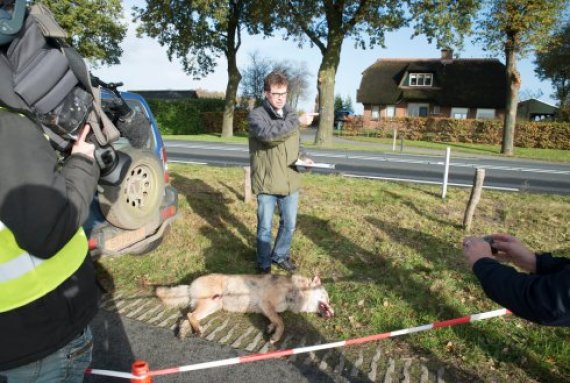Hugh Jansman next to the dead wolf in Kloosterhaar. © Photo WUR
This was revealed by a joint investigation of researchers from Utrecht and Wageningen. The wild animal was killed by traffic on 13 November, on the N343 between Kloosterhaar and Bergentheim, a couple of kilometres from the German border. Hugh Jansman (Environmental Research) and his colleagues from the Dutch Wildlife Health Centre (DWHC) in Utrecht performed a section on the animal.
Tapeworms
The collision caused extensive internal bleedings and fractures. ‘But no abnormalities were observed that would have increased the risk of a collision’, says pathologist Marja Kik of the DWHC. ‘The wolf was healthy.’ Other than some tapeworms, the wolf’s stomach and intestines were completely empty. Not even the fur of prey remained. Kik: ‘The animal hadn’t eaten in a while, possibly up to 48 hours.’
The wolf’s genetic profile was determined in Wageningen. Comparing this profile to the DNA profiles of the German Senckenberg Research Institute revealed that the wolf was a descendent of a wolf couple from Babben, in the Brandenburg region. This area is over 600 kilometres from where the animal was found in the Netherlands. The wolf appears to have been a young male, probably born in 2015.
Sheep
The wolf had presumably spent quite some time in the Netherlands. Sheep that were bitten to death in Laag-Zuthem (near Heino), Bergentheim and Beerzeveld were linked to the wolf. Samples from the sheep’s wounds match the DNA of the wolf. The wolf was also spotted several times in that period (12 October – 13 November).
The identification of the dead wolf was possible thanks to Wageningen’s collaboration with Denmark, Germany and Poland within the CEwolf Consortium. In this partnership, the genetic research into wolf populations is brought together. There are over 70 wolf packs living in Germany. The area of spread of the animals is increasingly shifting towards the Netherlands.


